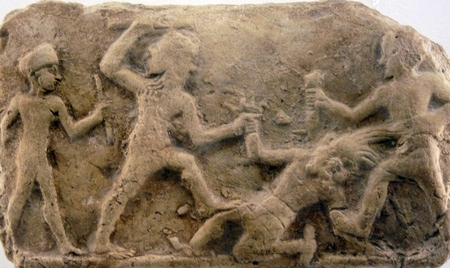 |
|||||||||||||
|
Sumer to Akkad Review "The Emerging Patriarchy: Sumer to Akkad". This terracotta relief (now at the Pergamon Museum in Berlin) shows the Uruk's king, Gilgamesh, and his companion Enkidu killing Humbaba, the guardian of the forest, in what is now Lebanon. 
"...As water levels dropped and the Persian Gulf receded due to natural climate change, residents transformed those channels, at the start of the third millennium b.c., into a network of canals crisscrossing the city that enabled Uruk’s inhabitants to move large quantities of goods cheaply and easily. Small boats navigated these man-made waterways, carrying piles of freshly bundled bright-green reeds, noisy sheep, and huge storage jars illed with barley and beer. fishermen hawked their catches from reed rafts. on the docks alongside the mighty euphrates, workers loaded larger ships with local textiles ready for export to distant lands and traders emerged from the holds of newly arrived vessels with cargoes of precious stones and ores mined from remote mountains. Among the closely packed mudbrick houses, verdant gardens and date palms provided fresh food and welcome shade. Looming over the busy scene were the two high mounds, Kullaba and Eanna, dominating the otherwise lat plain. While these likely began as two separate villages, at some point they became the center of a single expanding settlement. with each new generation of temples, palaces, and other administrative buildings, the mounds grew higher, and the life-giving Euphrates continued to pulse through the city. At Uruk’s peak, in about 2900 b.c., more than 50,000 people crowded into almost two-and-a-half square miles. Though that equates to the population of a modest American town such as Oak Park, illinois, it was several times greater than any other city of its day. And no other metropolis surpassed that until Babylon expanded two millennia later." ~from "The Everlasting City" by Andrew Lawler at academia.edu. Read the article... |
| Copyright © Redefining the Sacred. All rights reserved. | |